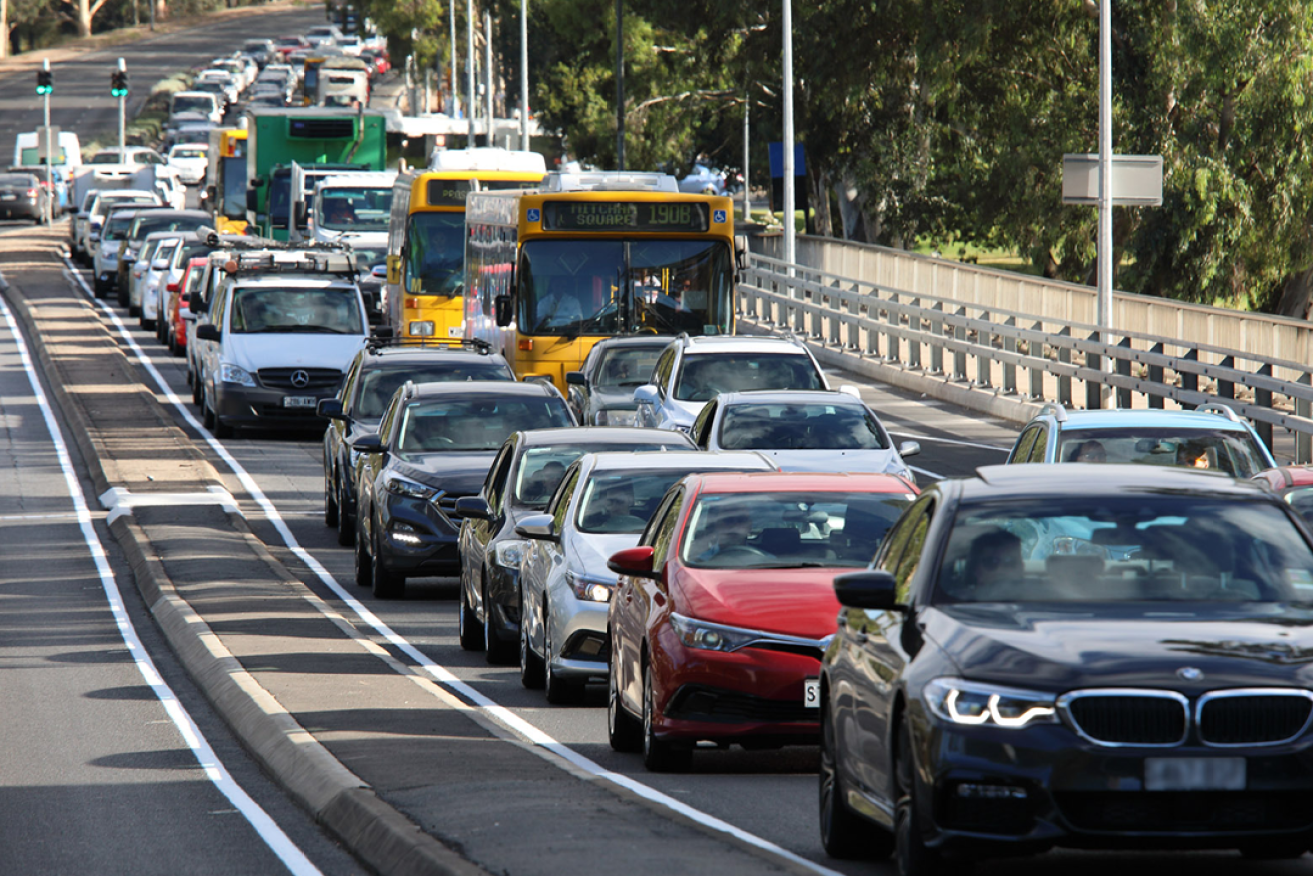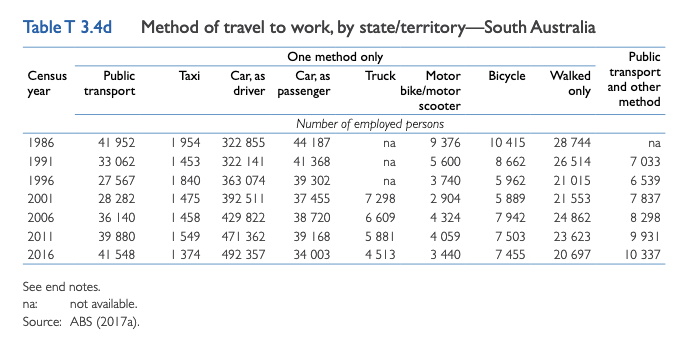Adelaide’s public transport users need a more powerful voice
It’s no wonder that public transport users are the bottom of the policy pile when the best-connected and most well-resourced transport lobby group in South Australia represents motorists.


Buses in the traffic queue on Morphett Street.
This might be the Adelaide media equivalent of shooting Bambi, but it’s time to question whether the RAA – an organisation that represents motorists – is the best organisation to guide debate on the city’s growing traffic congestion.
Every year the organisation releases congestion data for Adelaide’s key road routes, along with its prescription for what needs to be done to fix the problem. Last week, it neatly timed the release to coincide with street closures for the city’s V8 race – the most frustrating week of the year for Adelaide motorists.
The RAA’s contribution is increasingly ironic, because the key contributor to congestion on Adelaide’s wide streets is the persistently large proportion of people who choose private car travel over other transport options. In other words, the problem is being exacerbated by the RAA’s key constituency.
As a proportion of total kilometres travelled on our city streets, private vehicles contribute the lion’s share – more than 93 per cent, according to the latest Bureau of Infrastructure, Transport and Regional Economics data, just ahead of Perth.
Fewer of us now travel to work purely by public transport than did in 1986, thanks in part to the boom in “park and ride” carparks, while the number of people driving their own cars has skyrocketed. Even the number of people travelling as a passenger in a car has dropped.
Adelaide, as the RAA itself has noted, is obsessed with private car travel. We prefer to be at the wheel.

Source: BITRE Australian infrastructure statistics yearbook, 2018.
While the RAA does recognise that better public transport is one of the keys to easing congestion (which, indeed, is a problem for bus users as well as motorists), the detail of their public policy contributions shows that their fundamental agenda is to secure increased spending on roads.
The organisation – whose business now covers wide territory including roadside assistance, insurance, travel, advocacy, security and finance – is sober and accessible, and a decent corporate citizen, but it does not represent the interests of public transport users.
Take its contribution on the issue of Adelaide’s bus lanes.
Most cities in Australia and the world have a network of bus-only lanes to facilitate the passage of public transport and encourage people to leave their cars at home. In Adelaide, we have a relatively tiny network, with the RAA the most credible of the complainants against this modest attempt to facilitate bus movements.
The bus lanes in the Grenfell-Currie street corridor improved running times for buses, but the RAA could not believe that dedicated lanes for buses would have such an effect. They argued to the State Government that timetable changes could have been responsible for the improvement. The RAA actively lobbied against the Anzac Highway dedicated bus lane, which it argued increased congestion.
In its telling submission on the previous State Government’s “Integrated Transport and Land Use Plan” – a plan that was a long time coming and has been largely abandoned – the RAA made it clear that it supports public transport… but not if buses or trams get in the way of cars.
“The proposed improvements in public transport infrastructure are supported in principle, however RAA also believes that access and traffic flow for other vehicles needs to be maintained,” it says.
This argument, if accepted, would effectively rule out many improvements to public transport infrastructure, because it is obvious to anyone even vaguely interested in transport policy that trams on the road network and priority bus lanes, for example, do impinge on the space allotted to private vehicles. Adelaide’s urban development means that heavy rail isn’t a feasible option for many corners of the metropolitan area – buses and trams are our only option.
The RAA’s submission to the State Government of its funding priorities ahead of last year’s state budget barely mentions public transport.
In an ideal world, or even a less than ideal one, the most powerful representative of public transport users would be members of the Government.
The RAA says that Adelaide’s traffic congestion will be eased by more “efficient” public transport, but this isn’t going to happen if governments continue to prioritise the RAA’s other two solutions – spending hundreds of millions of dollars on the South Road corridor and upgrading the city “ring route”.
A majority of transport researchers believe in the concept of induced demand – that an expansion of a road corridor’s capacity generally has one enduring impact: attracting even more traffic.
The money-pit of the South Road upgrade won’t affect the travel experience of many road users in Adelaide, not to mention the rest of the state. But imagine the frequency of bus services, the quality of vehicles, and the other service innovations that could have been introduced if even a small proportion of the millions spent on South Road was directed towards public transport?
It almost goes without saying that the more people who switch from private cars to public transport, the better the traffic flow on our streets. Fifty people on a bus take up far less road real estate than 50 people in their cars.
The current State Government has so far provided scant positive vision for public transport: its key moves have been fulfilling its decision not to extend the tram network, reversing its policy position to institute a tram right-hand turn in the city, and cutting what it says are under-utilised bus services. The promised SA Public Transport Authority – which will make key decisions on services – has not yet been established. In any case, it will operate within resource and political parameters established by the Government.
Meanwhile, who is leading the debate on transport policy in South Australia? It’s a grab-bag of lobby groups, none of whom represent the interests of people who rely on public transport.
The RAA has the loudest voice, but there are also the various representatives of the trucking industry and the road builders and developers – all groups, in other words, with a vested interest in protecting and expanding the road-space for private and commercial vehicles.
Adelaide’s public transport lobby group, People for Public Transport, nearly disappeared ahead of last year’s election. The Liberal Government’s approach, I’m told by the group, has encouraged supporters to crank up its activities.
But it remains a small voice next to multiple cashed-up voices speaking for motorists and the freight and construction industries.
In an ideal world, or even a less than ideal one, the most powerful representative of public transport users would be members of the Government.
Thus far, counterproductively, they seem to be treating public transport as simply a cost, rather than a benefit to the many people who rely on buses, trains and trams, and the motorists who will enjoy a clearer run with fewer cars on the road.
Without significant additional Government investment in public transport, though, it’s unlikely that more Adelaide people will have the motivation to leave the car at home – at least in the immediate future.
Maybe one day, congestion will be so bad that the State Government and influential industry groups will look beyond self-interest and support the kind of public transport investment evident in every other major city in Australia.
Without it, the RAA’s congestion survey will continue to show an inexorable slowdown.
David Washington is editor of InDaily.
Want to comment?
Send us an email, making it clear which story you’re commenting on and including your full name (required for publication) and phone number (only for verification purposes). Please put “Reader views” in the subject.
We’ll publish the best comments in a regular “Reader Views” post. Your comments can be brief, or we can accept up to 350 words, or thereabouts.
InDaily has changed the way we receive comments. Go here for an explanation.




